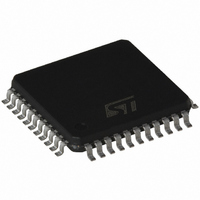TDA7407DTR STMicroelectronics, TDA7407DTR Datasheet - Page 31

TDA7407DTR
Manufacturer Part Number
TDA7407DTR
Description
IC PROCESSOR ADV SIGNAL 44-LQFP
Manufacturer
STMicroelectronics
Type
Car Signal Processorr
Datasheet
1.TDA7407.pdf
(46 pages)
Specifications of TDA7407DTR
Applications
Automotive Systems
Mounting Type
Surface Mount
Package / Case
44-LQFP
Lead Free Status / RoHS Status
Lead free / RoHS Compliant
Available stocks
Company
Part Number
Manufacturer
Quantity
Price
Company:
Part Number:
TDA7407DTR
Manufacturer:
STMicroelectronics
Quantity:
10 000
TDA7407
5.3
5.3.1
5.3.2
5.4
Automatic threshold control mechanism
Automatic threshold control by the stereoblend voltage
Besides the noise controlled threshold adjustment there is an additional possibility for
influencing the trigger threshold. It is depending on the stereoblend control.
The point where the MPX signal starts to become noisy is fixed by the RF part. Therefore
also the starting point of the normal noise-controlled trigger adjustment is fixed. In some
cases the behaviour of the noiseblanker can be improved by increasing the threshold even
in a region of higher fieldstrength.
Sometimes a wrong triggering occures for the MPX signal often shows distortion in this
range which can be avoided even if using a low threshold. Because of the overlap of this
range and the range of the stereo/mono transition it can be controlled by stereoblend.
This threshold increase is programmable in 3 steps or switched off with bits D0 and D1 of
the fieldstrength control byte.
Over deviation detector
If the system is tuned to stations with a high deviation the noiseblanker can trigger on the
higher frequencies of the modulation. To avoid this wrong behaviour, which causes noise in
the output signal, the noiseblanker offers a deviation dependent threshold adjustment.
By rectifying the MPX signal a further signal representing the actual deviation is obtained. It
is used to increase the PEAK voltage. Offset and gain of this circuit are programmable in 3
steps with the bits D6 and D7 of the stereo decoder byte (the first step turns off the detector,
see fig. 18).
Functional description of the multipath detector
Using the internal multipath detector the audible effects of a multipath condition can be
minimized. A multipath condition is detected by rectifying the 19kHz spectrum in the
fieldstrength signal.An external capacitor is used to define the attack and decay times (see
block diagram
capacitor of about 47nF and additionally the MPIN pin is selected to be the fieldstrength
input.
Using the configuration, an external user requirement adaptation is given in
To keep the old value of the Multipath Detector during an AF-jump, the external capacitor
can be disconnected by the MP Hold switch. This switch can be controlled directly by the
AFS Pin.
Selecting the "internal influence" in the configuration byte, the channel separation is
automatically reduced during a multipath condition according to the voltage appearing at the
MP_OUT pin. A possible application is shown in
Figure
24). the MPOUT pin is used as detector output connected to a
Figure
24.
Multipath detector
Figure
24.
31/46














